On June 8, 2023, to demand a cease of the violence against Zapatista communities, different collectives and organizations throughout the country carried out acts of protest and pronouncements directed at the local and federal governments of Mexico as well as the international community.
A significant part of the statement in San Cristobal de las Casas was a document based on the investigation (by 3 caravans to the BAEZLN organized by red Ajmaq) of the violations against Zapatista communities by paramilitaries and by the government’s strategies to subjugate the autonomous communities.
Below we share the document:
In the Cuxuljá crossroads, located between the San Cristóbal and Ocosingo highway, aggressions against the BAEZLN have increased since 2019 to date. It is part of Moises and Gandhi region conformed by several towns, communities and ejidos belonging to the Autonomous Municipality Lucio Cabañas, these are: Ejido Moises Gandhi (property San Juan, Oken-chay), Emiliano Zapata, San Isidro, Predio la Codicia, community San Antonio las Flores, community Sacrificio la Esperanza, ejido 31 julio, Ejido la Resistencia.
In the area of Patria Nueva where Nuevo San Gragorio and Moisés Gandhi are located; in MARZ Lucio Cabañas, civilian observation missions and documentation and dissemination caravans have been carried out by different organizations, collectives and people in solidarity who report the serious violations of human rights by armed groups and the silence of the three levels of government in the face of this situation.
COMMUNITY OF MOISES and GANDHI
Since April 2019, the Zapatista community of Moises and Gandhi, which belongs to Caracol 10, “Floreciendo la Semilla Rebelde,” has been the target of aggressions by ORCAO, motivated by an agrarian interest in the dispossession and distribution of recovered lands that legitimately belong to the EZLN (the same reason that motivates invaders in the community of Nuevo San Gregorio).
These aggressions began with fences and land seizures in the work sites of the recovered lands (by the Zapatistas), and with damage and destruction of the collective crops. For instance, on December 17, where 235 people from ORCAO destroyed wire fences, pastures and crops, and then destroyed houses and cooperative stores belonging to Zapatista families.
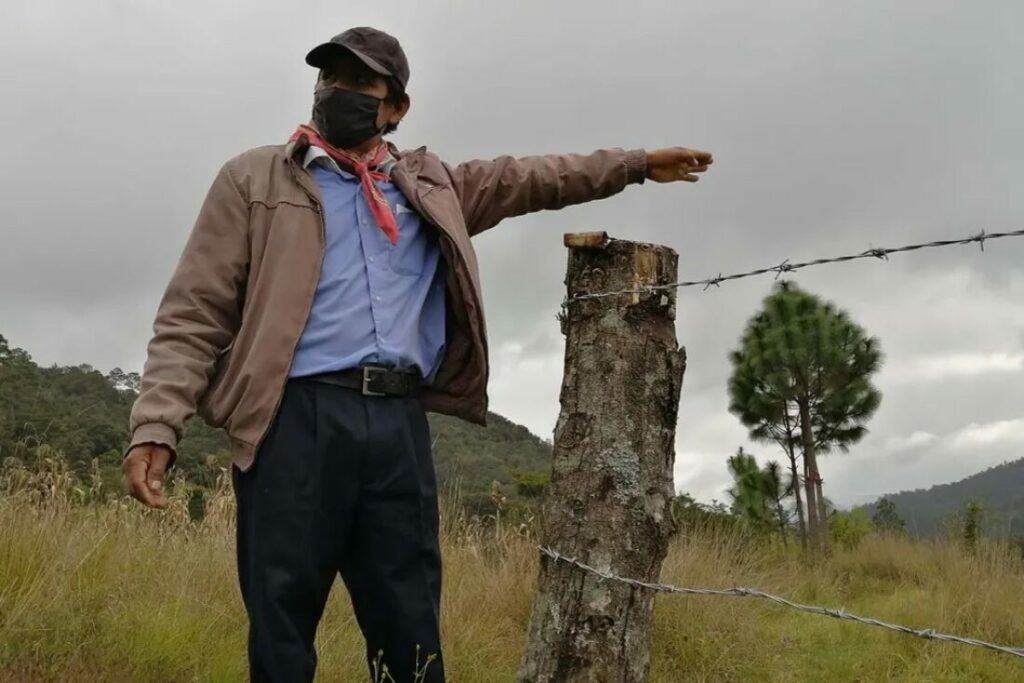
According to records, between January and November 2020 there were 99 cases of aggression against the communities in the region of Moises and Gandhi. The mode of operation centered on theft of crops, destruction of wire fences and posts, presence of armed people with portable radios in the community, setting up guards, threatening verbally and in writing; intimidations and physical aggressions to BAEZLN, burning and fumigation of crops, theft of the stores of the autonomous communities, burning of beehives, destruction of the Autonomous High School and detonation of firearms.
Since June 2020 the aggressions have increased, now with more gunshots, logging of oak trees, more destruction, looting and physical aggressions to members of the population of Moises and Gandhi.
Between June and October 2020, there have been several attacks and firearms shots of different calibers carried out by ORCAO in the interior of the autonomous communities, putting at risk men, women, boys, girls, and elderly people who were forced to seek refuge from bullets, or to throw themselves in the mud in the middle of the night as the attacks have lasted for whole nights and days. In addition, this situation has not allowed the Zapatistas to work the land, for they have had to stay inside their houses or take refuge in other houses.
The events have intensified with several attacks with high caliber weapons directed at the autonomous communities, followed by the burning of the coffee warehouses and the “Compañera Lucha” dining room followed by the looting of the Arco Iris store, among other destructions.
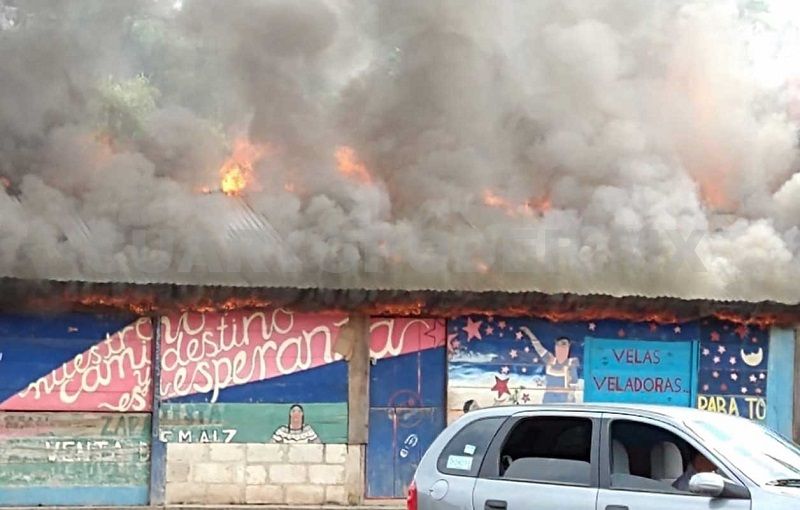
After the burning of the coffee warehouses the aggressions did not stop, and there were attempts to establish a dialogue between the two parties (EZLN and ORCAO), but this attempt failed as the armed aggressions have not stopped and ORCAO has not complied with the agreements.
In 2020 alone, the economic costs of this wave of attacks in the Region of Moses and Gandhi, totaled MXN 1,456,021.06 (84,000USD) and that for damage to cornfields, trees and materials in the towns of the Region of Peace, destruction of properties, regional goods, assets in zapatista municipality, damage and theft in the Arco Iris store. After more than three years, the aggressions have not stopped and the material damages have increased. Nevertheless, it has been impossible to quantify economically all the psycho-social and community damage to the Zapatista communities as a result of the violation of their human rights.
NEW SAN GREGORIO
The community of Nuevo San Gregorio belongs to the Lucio Cabañas Autonomous Municipality, Caracol 10, “Floreciendo la Semilla Rebelde” (Flourishing the Rebel Seed), has an area of approximately 155 hectares of land recovered since 1994. In this community the BAEZLN have suffered constant harassment, intimidation and provocations by a group called “The 40 invaders”. These acts have occurred since November 2019 to date. The main form of aggression has been land invasion, armed attacks, harassment against girls, boys, men and women of this autonomous Zapatista community.
“The 40 invaders” come from close by the ejidos of San Gregorio Las Casas, San Andrés Puerto Rico, Ranchería Duraznal and Rancho Alegre. Some of its members have or had ejidal and ecclesiastical positions, and are landowners in their ejidos. Among the leaders are identified Nicolás Pérez Pérez, former PRD councilman in Huixtán (2008-2010), owner of 60 hectares of land in the Buena Vista community, municipality of San Cristóbal; Sebastián Bolom Ara, former Huixtán official (2016- 2018); Pedro Hernández Gómez, ejidatario in San Gregorio Las Casas; and Javier Gómez Pérez, ejidatario in Ranchería Duraznal. This group also includes former Huixtán police officers. This group of invaders acts with impunity, executes criminal acts, implements strategies to divide the community through political parties, distributes social programs to facilitate community division, and offers to sell the recovered lands to other owners outside of the community.
The group of 40 invaders do not want the land because they need it to live, but rather they want it for business, as all of them have their own land in the 4 communities to which they belong. That is why the three proposals made on February 27, 2020, by the community of Nuevo San Gregorio and the Good Government Board, when trying to establish a dialogue with the invaders, were rejected by this group.
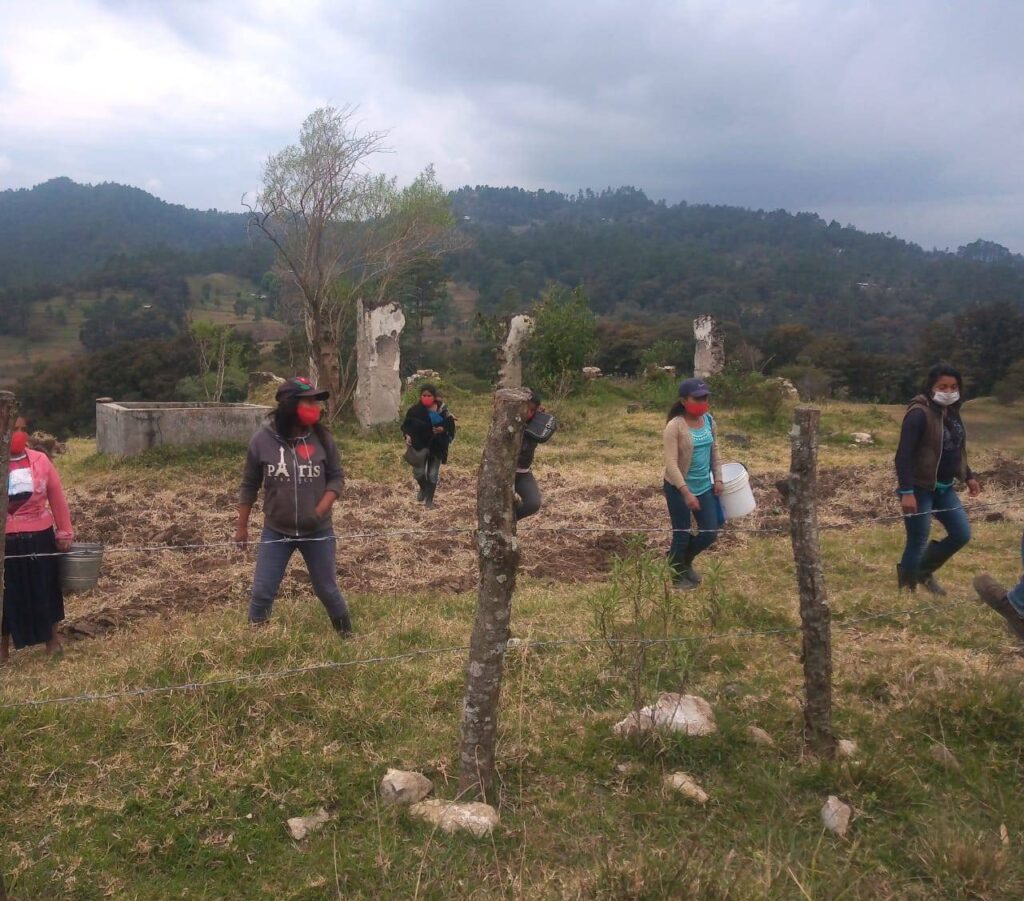
These proposals were:
1) That the land be worked collectively; or.
2) Give them (the invaders) one hectare per person; or
3) Divide the 155 hectares in half.
The following is an account of the aggressions by the group of 40 invaders since December 2019.
-The invaders began by fencing off the water tank that distributes water to the community, disconnecting hoses that were used to irrigate the different crops, and disconnecting the pipes for the fish pond; they burned the hose that was used to irrigate the collective vegetable garden. The cutting of hoses that supplied water to different areas of the community has caused illnesses and has caused death of collective and individual livestock of Zapatista families.
– Theft of vegetables and destruction of medicinal and fruit plants. In the area where the Zapatista vegetable garden is located, they divided the land into fractions of 40.5 meters each in order to individualize the land.
– Threats against Zapatista women and harassment of men by invaders carrying sticks, machetes and clubs.
– Surveillance and intimidation from a distance, taking photos and video in the direction of Zapatista people to harass-assassinate families on their own land. They also keep a close watch on the houses of Zapatista support bases. The invaders continue to keep the collective carpentry workshop and the center of the community under surveillance; they install guards 50 meters from the center of the community where the Zapatista support bases are concentrated. The invaders establish themselves permanently in the “Casa Grande”; they install guards in 5 locations to watch, observe with binoculars and take photos of the Zapatista families and members of the observation and documentation caravan.
– Invasion and fencing of the cornfields and fruit trees of the secondary school.
– Fencing of the collective pasture of the town, the collective cattle of the BAEZLN that remained within the fence were left without food and water, then they began to burn plots cattle was kept; they moved the cattle out of the places where their owners located them, many of the cattle died of hunger.
– They fenced the electric post at the community old church, the electric post of the water pumping line and the tractor of the region, impeding its functionality.
– The invaders have prevented the Zapatista bases from planting and harvesting their food; they have taken measurements and have marked individual plots in these same lands where before there were spaces for vegetables, fruit trees, medicinal plants and livestock of the Zapatista support bases.
– The group of invaders have begun cutting down trees on the invaded lands.
– As of January 2022, the invaders had reduced the space and way of life, transit and production of the Zapatista families to three and a half hectares, of the 155 hectares of recovered land, reducing the population center to half a hectare, and leaving three hectares dispersed and fragmented. They have fenced off and kidnapped the roads, forests, springs and rivers. They have plundered the crops and stolen animals from the collective works; they continue destroying the forests, and have killed the animals. Today the situation is even more critical.
The offensive against the land and territory shows us the attack against the three fundamental axes for the Zapatista Autonomy in Nuevo San Gregorio: production for food self-sufficiency; autonomous education and autonomous health.
In this context of prolonged torture by ORCAO, a profound crisis has been generated in Zapatista communities in the region of Moises and Gandhi. Likewise, in Nuevo San Gregorio the group of the 40 invaders continues to put the Zapatista families to the limit, imposing on them a daily and permanent state of war.
Thus, the facts described above are showing us diverse mechanisms of violence deployed by armed groups and invaders. Actions that come, either by agreement or omission, hand in hand with the policies of the three levels of bad government: Federal, State and Municipal.
The following is a list of the mechanisms of violence:
1.-Invading land and destroying nature through domination and terror over a territory and its population, they dispossess the guardians of the land to use Mother Nature as merchandise. This is how they encircle and parcel the land recovered from collective use to individualize it. There is logging and felling of trees for commercial use; mountains are destroyed for the extraction and sale of gravel/stone, such as the alarming case of the community of La Resistencia.
2. Fencing with wire fences and a bullet-ridden environment: Once the invasion and destruction is exercised, the violent act of encircling to harass-assassinate as a “kidnapping” on the land of the same villagers.
The ORCAO and groups of armed people implement acts of cruelty typical of war that:
a) expose Zapatista families to dodge bullets, mainly women who have to watch their backs and breasts to protect their babies and children;
b) force men and women to cross countless wire fences to access water, obtain their food and to care for their plants, crops and animals;
c) violate the right to exercise the right to life, liberty and dignity of the Zapatista people;
d) violate the right to education, health and self-supporting peasant-indigenous economy.
3. violate the right to access water. Roads and passageways to the creek, spring and pumping system to obtain water and reach the wetland are closed.
4. Cause hunger. Families cannot go out to work the fields because they are being shot at. In one of the communities, 50% of the community’s food production was lost as a result of the invasion, the encirclement and the shooting. The bean harvest was lost, as well as the collective harvest of regional wheat. The communal and collective vegetable garden was invaded by the cattle of one person from the invaders’ group. In Nuevo San Gregorio it has not even been possible to cultivate any more.
5. Destroying the autonomous economy. Burning and destruction of stores, dining halls and cooperatives. Theft of working tools as well as the harvest of corn, wheat, yucca, beans, fruit trees, etc.
6. Violence of defamation, slander and disinformation. ORCAO and the group of armed people discredit, reject and minimize the acts of violence, robbery and destruction that they have carried out. Continued defamation, slander and disinformation regarding the life project and the autonomous organizational form of the Zapatista peoples.
7. Violence towards women’s bodies-territories. There has also been an increase in harassment towards Zapatista women support bases, since these women have taken on some community tasks that they used to do together with their compañeros, with the objective of avoiding direct provocations from the invaders towards the men of the community.
Among other things, the Zapatista women take care of the livestock, as well as turning on and off the pump that supplies water to the center of the village. There is danger for the women every time they go to get firewood, to give the animals water to drink, to go to the small plot of land to get something to harvest, to take care of their houses and chickens; in other words, they cannot move freely because there is constant intimidation.
In the face of this situation of aggressions, the Zapatista families have not fallen into provocations and continue in their determination to defend life. We note that the political commitment of the Zapatista communities is for life and from the autonomies. The families organize themselves to create and sustain the collective work of the cornfields, the bean fields, the production of chickens, fish and cattle, as well as the women’s pottery collectives, handicraft cooperatives, collective stores and carpentry. Sustaining the areas of health and autonomous education with their promoters, women, youth, boys and girls rehearse art, culture and education. The people decide their own forms of self-government, from their own system of self-government and from the respect, attachment and care for Mother Earth.
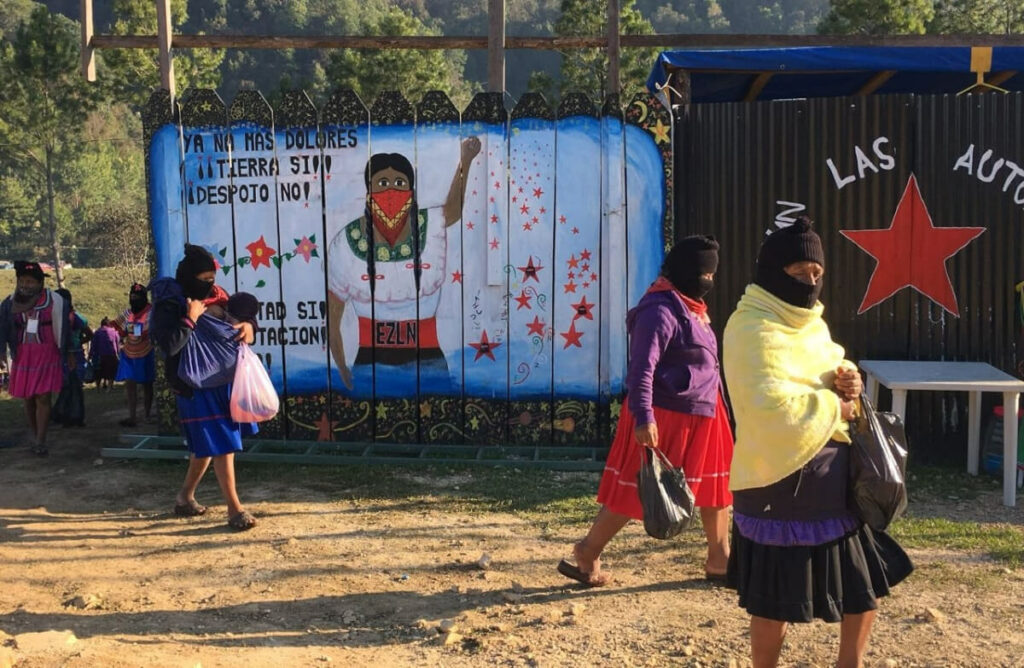
WHY ARE THE ZAPATISTA COMMUNITIES BEING ATTACKED?
Since the uprising of the Zapatista Army of National Liberation (EZLN) on January 1, 1994, thousands of hectares of land usurped by landowners were recovered by their legitimate owners: the original peoples. From there, the 1994 War began, and has continued with a counterinsurgency strategy, designed and implemented in an integral manner through different ways in order to wear down and disarticulate the Zapatista families, communities and peoples. The government of AMLO and the “Fourth Transformation” continues the counterinsurgency model; human rights continue to be violated, using a supposed electoral legitimacy to do the same criminal work of the previous governments of the PRI, PAN and PRD, thus dispossessing the land and common goods to convert them into merchandise.
Now the intention is not only to put an end to the life project proposed by the EZLN but also to all the peoples who resist megaprojects such as the misnamed Mayan Train, the Palenque-San Cristóbal-Tuxtla-Pijijiapan Super Highway, which is being achieved by means of militarization and assistance from National Guard (GN) to protect the development of these megaprojects and the implementation of programs such as the Sembrando Vida, better known in the communities as “sowing envy”, in order to exterminate community life.
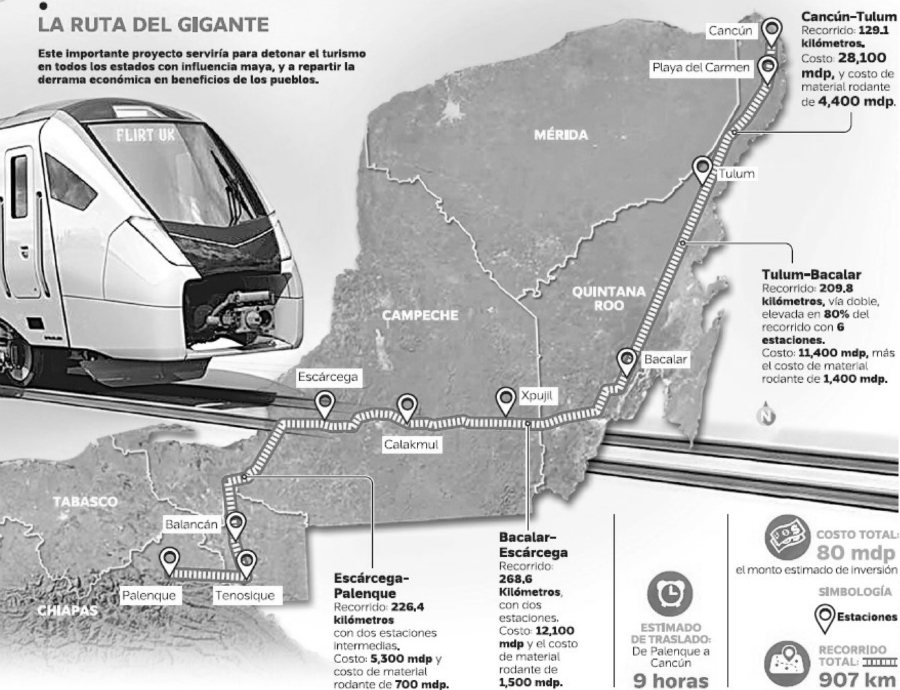
The construction and location of the National Guard is not where there is a greater presence of organized crime and drug trafficking, but where there is greater indigenous organization and mobilization in defense of land and territory. An example of this is the construction of the Chilón headquarters in the northern zone, which aims to expand the perimeter of control of the 39th Military Zone and is articulated with the Sembrando Vida project in the Ocosingo jungle zone, which is creating a community division to expedite the privatization/individualization of collective lands with the help of the same young people from the communities who are enrolled in the “Jóvenes Construyendo Futuro” (Youth Building a Future) program.
The lack of intervention or concerted action by the alleged “Fourth Transformation” against the different groups of aggressors in the Zapatista territory has provoked damages that threaten the physical and mental health of the Zapatista support bases. it is against their right to food in addition to the destruction of both individual and collective goods, destruction of nature and thievery of lands recovered and in legitimate possession of the EZLN since 1994.
Today, in times of the IV Transformation, we continue to identify several fronts of the integral war of attrition:
– THE AGRARIAN WAR FRONT, which seeks to generate confusion about the ownership of land and territory, in order to immediately provoke disputes over access to it, channeling permanent harassment towards the Zapatista peoples settled on recovered lands. For years, this harassment has also been encouraged by land certification programs such as: Procede, Procecom, Fanar, Raja, to perpetrate the plundering of natural common goods and thus dispossess the communities of their agrarian rights.
– THE MILITARY FRONT, the implementation of a military geographic encirclement, in articulation with paramilitary groups that are financed and trained with the permissiveness and logistical support of the State and the Mexican Army, besiege and intimidate the Zapatista communities.
– THE WELFARE FRONT with social programs implemented by the different political parties allied to paramilitary groups that are in charge of invading, stealing and destroying the production of Zapatista families; with which they intend to destroy the autonomous economy.
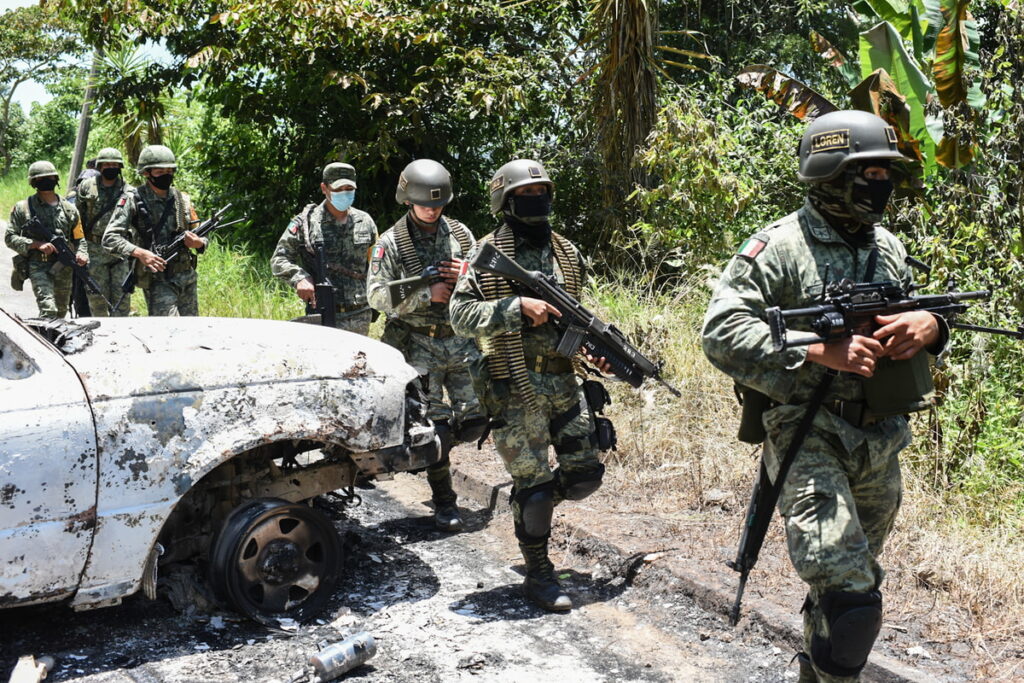
– THE MEDIA FRONT that serves to misinform, delegitimize, criminalize and/or slander the political-ethical proposal of the EZLN.
Thus, the strategy is to articulate various tactics ranging from an information campaign of contempt for the EZLN, the presence of the National Guard and armed groups, the implementation of megaprojects and de-peasantization programs such as Sembrando Vida (Sowing Life). With the objective of dispossessing the Zapatista peoples of their recovered land.
In spite of the constant attacks throughout these years on the Autonomous communities, the EZLN and its bases do not get tired and continue to nourish the hope of taking care of the land, of promoting collective work, of taking care of life, of calling for solidarity to give a civil and peaceful solution to the different aggressions in their territories.
Almost 30 years after the Zapatista uprising of 1994, the Zapatista communities have managed to strengthen the different activities that make up their process of autonomy: health, food, education, justice, agroecology and economy, promoting art, science, culture and sports in freedom for women, children, and Zapatista and non-Zapatista men and women, all this with the conviction that another world is possible.
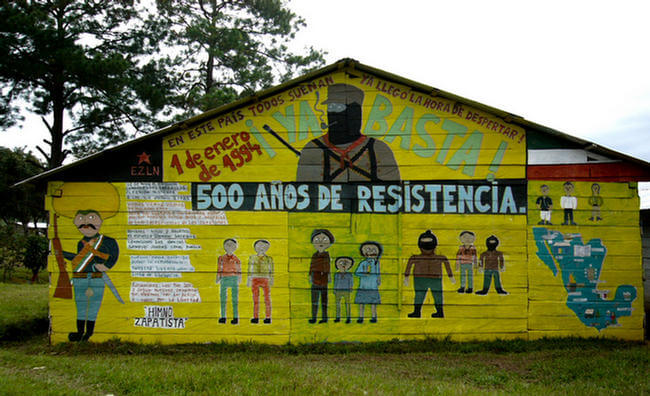
LONG LIVE THE EZLN!
LONG LIVE AUTONOMY!
